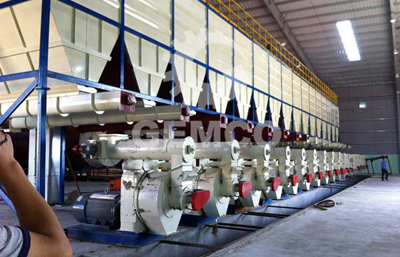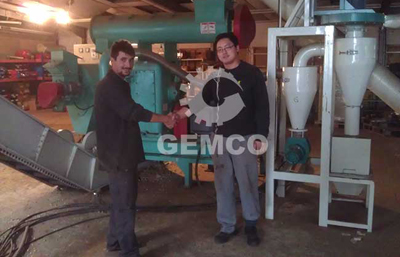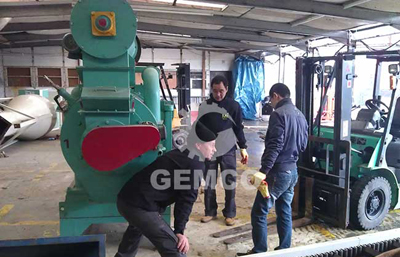Analysis of the combustion characteristics of 8 kinds of biomass pellets
Biomass pellets are convenient to store, transport and use. They are clean and renewable, with high combustion efficiency. In this article, we analyzed 8 different biomass pellets by comparing their ignition temperature. Among them, decoration paper pellets has the lowest ignition temperature, and the rice husk has the highest. Besides, by observing the ash residues of pellet fuel, we conclude that the ash of biomass pellet fuel gradually turn white from black, turn hard from soft, and generate slag from 740℃ to 920℃.
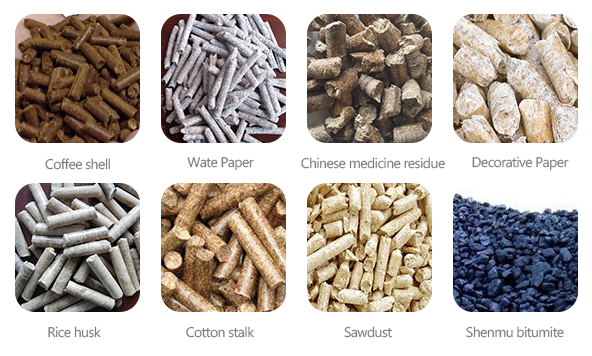
About biomass pellet fuel
Making biomass into pellets is a common way to make use of biomass energy. Usually, biomass pellets are cylindrical solid fuel. Their diameter is less than 25mm, the density is 1.2-1.4kg/m3, and the volume is 75%-90% less than bulky materials. They are easy to store and transport. Besides, they have uniform size and high fluidity, so they can be applied in automatic transmission and burning. Biomass pellets have high burning efficiency, with little carbon, NOx or SOx emission, so they are environmental friendly.
The burning performance of biomass pellets is determined by their shape and porosity. The thicker the pellets, the longer the burning time. Besides, pellets with higher porosity are easier to burn, they also have better burning performance.
In this article, we’ll compare the burning performance of different biomass pellets by working out their ignition temperature under different condition.
Combustion models and theory
To understand the ignition characteristics of biomass pellets, we introduced a combustion model. This model has the following premises:
- The burning process is in quasi steady state.
- The pellets burn in infinite and static environment.
- The burning media contains only oxygen and inert gases.
- Biomass pellets are cylinders. The burning is a condensation reaction. The density of core is constant.
- We don’t consider pellets breakage in burning. A pellet has 2 sections theoretically.
- The density of biomass pellets increase during combustion. Their burning process is similar with other solid fuel.
The complete burning process of a pellet fuel

Chart 1 present the burning process of a pellet. It can be roughly divided into 2 parts: the burning of volatiles and coke pellets.
First, the pellet fuel is heated up and dried. Then the volatiles separate out. Under high temperature and with enough oxygen, the volatile combustible burns around the pellets and generate bright flame. The oxygen is consumed by the volatile gas, and it can’t reach the surface of coke, so the core temperature of the cock is under 600-700℃. That is to say, the oxygen consumption of volatiles hinder the burning of coke.
The coke pellets will be heated up by the burning volatiles around it. When the volatiles burns out, the oxygen consumption sharply decreases, and the coke pellets will burn rapidly. In this process, the burning of volatiles contributes to the burning of coke pellets. The combustion begins in parts of the pellet surface and spreads to the whole surface. At the same time, the temperature of the coke pellets reach up to its highest level.
During the combustion of coke pellets, there are a little blue flames around it. They are mainly CO. The volatiles keep separating out in the burning of coke pellets, but they take a second place in this stage.
Combustion effect indicators
The ignition temperature of biomass pellets indicate whether they are easy to burn. It reflect the burning performance of a biomass pellets. According to the theory of 2 Chinese scholars, Fu Yizhang and Liao Yan, the ignition and burning performance are influenced by the volatile content in biomass pellets, moisture content and fixed carbon content.
In this experiment, we use 5E-MAC ir coal analyzer to test the biomass pellet fuel, a high-precision electronic scale, and a ceramic fiber furnace with a temperature control system. The computer program will work out the moisture, volatile and ash content by measuring the weight under different temperatures.
We analyzed 8 different biomass pellet fuel. They are made of coffee shell, paper, Chinese medicine residue, decorative paper, corn stalk, rice husk, cotton stalk, sawdust and Shenmu bitumite. Their diameters are 8mm, and the density is 1100kg/m3.
| Sample % | Moisture % | Volatiles % | Fixed carbon % | Calorific value (MJ/kg) |
|---|---|---|---|---|
| Coffe shell | 5.77 | 64.30 | 15.25 | 20.868 |
| Paper | 8.34 | 70.79 | 14.89 | 19.381 |
| Chinese medicine residue | 9.69 | 68.93 | 13.48 | 20.955 |
| Decorative paper | 7.04 | 76.74 | 14.25 | 22.170 |
| Corn stalk | 3.88 | 70.96 | 14.62 | 22.535 |
| Rice husk | 4.68 | 52.25 | 13.91 | 16.852 |
| Cotton stalk | 5.24 | 61.48 | 14.88 | 19.434 |
| Sawdust | 5.75 | 66.96 | 15.09 | 21.819 |
| Shenmu bitumite | 2.60 | 32.76 | 58.08 | 28.37 |
From the chart, we can get the following conclusion:
Compared with traditional fossil fuel, biomass pellets have high volatile content of 60%-70%, so it is easy to ignite. The Fixed carbon content is only 15%, so the heat value is low.
Moisture content
Generally, the higher moisture content means the lower combustible content and calorific value. Meanwhile, high moisture content makes the biomass pellets hard to ignite, and influence the burning speed. As the chart above shows, the water contents in all biomass pellets are less than 10%. With the lowest moisture, corn stalk is easier to be ignited.
Volatile content
The volatiles in biomass pellets and their heat value have great effect on the ignition and burning performance. When the pellet fuel get heated, volatiles separate out and start to burn. Volatiles with high heat value have high initial temperature when they separate out. As the chart shows, the volatiles is the highest in decoration paper pellets. So they are easy to ignite, and the combustion is stable.
Ash content
Ash is an incombustible content in biomass pellets. The higher the ash content, the less the combustible content, the lower the heat value, and the lower the burning temperature. As the chart show, rice husk has the highest ash content, so the heat value is low, and it is hard to ignite.
Burning performance of different biomass pellets
The burning performance of biomass pellets are reflected by the ignition temperature. The lower the ignition temperature, the better the burning performance. According to the experiment data, the ignition temperature from the lowest to highest are: decorative paper, Chinese medicine residue, paper, corn stalk, sawdust, coffee shell, cotton stalk, rice husk.
According to the theory of Liao Yan, every content has a specific effect on the burning performance. Volatiles have positive effect. The higher the volatiles content, the lower the ignition temperature. But the fixed carbon has negative effect. The higher the fixed carbon content, the higher temperature they need to be ignite. Besides, the separating process of volatiles and moisture will form pores in the pellet fuel and improve the combustion.
Appearance of ash residues
The ash residues of different biomass pellets have different appearances. The picture above shows the ash residues of rice husk, cotton stalk, sawdust, and corn stalk after burned at the temperature of 920℃.

- Rice husk has the highest slagging rate. The ash looks white.
- Sawdust has slight slagging degree. The ash is gray and white, and feels soft.
- Corn stalk has ash content of 10.54%. The ash is a little hard, with some slag.
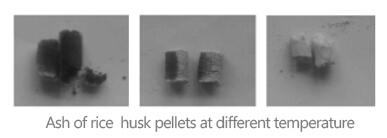
This picture shows the ash appearance at the temperature of 740℃, 840℃ and 920℃. With the increase of temperature, the color of ash turn white from black, the ash become harder and slagged.
The appearance of ash residues reflect different existing forms of inorganic matter. Acidic oxide (like Al2O3, SiO2) in ash can raise the fusion point of pellet fuel ash. The higher the Acidic oxide content, the higher the melting temperature. On the contrary, alkaline oxides (K2O, Na2O, CaO, MgO, Fe2O3) can lower the fusion temperature. The higher the alkaline oxides content, the lower the melting temperature. As the experiment shows, the slag degree is higher in corn stalk pellets, we can infer it container more alkaline oxides.
Conclusion
By analyzing the ignition temperature of different biomass pellets, we draw the following conclusions:
- Compared with traditional fossil fuel, biomass pellets have higher volatile content and lower fixed carbon content. They determines biomass pellet fuel are easy to be ignite, but the heat value is relatively lower.
- Of the 8 biomass pellet fuels we have test, the ignition temperature from the lowest to the highest are: decorative paper, Chinese medicine residue, paper, corn stalk, sawdust, coffee shell, cotton stalk, rice husk.
- From 740℃ to 920℃, the ash of biomass pellet fuel gradually turn white from black, turn hard from soft, and generate slag. Corn stalk pellets are easier to melt and slag for the high alkaline oxides.
We receive enquiries in English, Español (Spanish), Русский язык (Russian), Français (French) and العربية (Arabic). Our professional team will reply to you within one business day. Please feel free to contact us!
